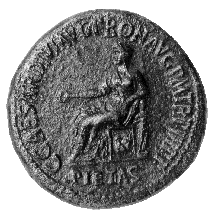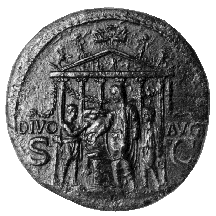



(71) Gaius ("Caligula") - AE sestertius, A.D. 39-40,
27.44 g. (inv. 91.128).
Obverse: Draped and veiled Pietas seated l., holding patera in r.
and resting l. on small figure forming part of seat; C(AIVS) CAESAR DIVI
AVG(VSTI) PRON(EPOS) AVG(VSTVS) P(ONTIFEX) M(AXIMVS) TR(IBVNICIA) P(OTESTATE)
III P(ATER) P(ATRIAE): Gaius Caesar, great-grandson of Divine Augustus,
Augustus, pontifex maximus, with tribunician power for the third
time, father of the country; in exergue, PIETAS: Pietas.
Reverse: Before hexastyle garlanded temple surmounted by quadriga, Gaius,
togate and veiled, sacrifices with patera over garlanded altar; attendant
to l. leads bull to altar; attendant to r. holds patera; DIVO-AVG(VSTO):
to Divine Augustus; S(ENATVS)- C(ONSVLTO): by decree of the Senate.
Provenance: Coin Galleries, 1959.
Bibliography: C.H.V. Sutherland, The Roman Imperial Coinage I: from 31
BC to AD 69, rev. ed. (London 1984) 44; P.V. Hill, The Monuments
of Rome as Coin Types (London 1989) 19-21.
The emperor Tiberius was succeeded by Gaius Julius Caesar Germanicus, the
only male member of the family of the popular Germanicus to survive the
plots of Tiberius and his adviser, Sejanus, who had feared their interference
with the succession. Officially known as Gaius Caesar, he accompanied his
father on his assignment at the Rhine frontier, where the soldiers nicknamed
him Caligula or Little Boot for the miniature military outfit he wore there.
As emperor he became increasingly autocratic, cruel, and extravagant, and
his troops assassinated him in A.D. 41.
Few of Caligula's coins refer to specific events in his reign, emphasizing
instead his family and particularly his relationship to Augustus. On the
obverse of this sestertius the usual portrait of the emperor has been replaced
by the personification Pietas, who refers particularly to the obligation
to honor the family. The legend specifically identifies Caligula's relationship
to Augustus, and on the reverse the emperor sacrifices to Augustus in front
of the Temple of Divine Augustus, which was begun by Tiberius but dedicated
by Caligula in A.D. 37. This coin type was first issued in A.D. 37 to commemorate
the dedication of the temple and later revived.
C.L.L.



All contents copyright (c) 1996.
Lawrence University
All rights reserved.